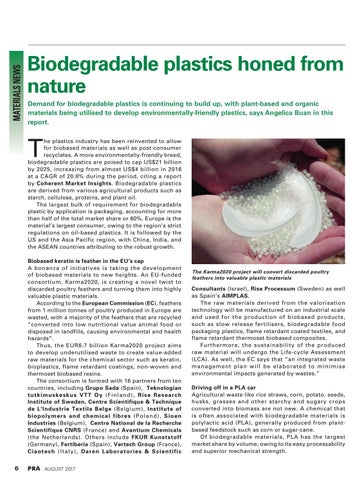Materials News
Biodegradable plastics honed from nature Demand for biodegradable plastics is continuing to build up, with plant-based and organic materials being utilised to develop environmentally-friendly plastics, says Angelica Buan in this report.
T
he plastics industry has been reinvented to allow for biobased materials as well as post-consumer recyclates. A more environmentally-friendly breed, biodegradable plastics are poised to cap US$21 billion by 2025, increasing from almost US$4 billion in 2016 at a CAGR of 20.8% during the period, citing a report by Coherent Market Insights. Biodegradable plastics are derived from various agricultural products such as starch, cellulose, proteins, and plant oil. The largest bulk of requirement for biodegradable plastic by application is packaging, accounting for more than half of the total market share or 60%. Europe is the material’s largest consumer, owing to the region’s strict regulations on oil-based plastics. It is followed by the US and the Asia Pacific region, with China, India, and the ASEAN countries attributing to the robust growth. Biobased keratin is feather in the EU’s cap A bonanza of initiatives is taking the development of biobased materials to new heights. An EU-funded consortium, Karma2020, is creating a novel twist to discarded poultry feathers and turning them into highly valuable plastic materials. According to the European Commission (EC), feathers from 1 million tonnes of poultry produced in Europe are wasted, with a majority of the feathers that are recycled “converted into low nutritional value animal food or disposed in landfills, causing environmental and health hazards”. Thus, the EUR6.7 billion Karma2020 project aims to develop underutilised waste to create value-added raw materials for the chemical sector such as keratin, bioplastics, flame retardant coatings, non-woven and thermoset biobased resins. The consortium is formed with 16 partners from ten countries, including Grupo Sada (Spain), Teknologian tutkimuskeskus VTT Oy (Finland), Rise Research Institute of Sweden, Centre Scientifique & Technique de L'Industrie Textile Belge (Belgium), Institute of biopolymers and chemical fibres (Poland), Sioen Industries (Belgium), Centre National de la Recherche Scientifique CNRS (France) and Avantium Chemicals (the Netherlands). Others include FKUR Kunststoff (Germany), Fertiberia (Spain), Vertech Group (France), Ciaotech (Italy), Daren Laboratories & Scientific
6
AUGUST 2017
The Karma2020 project will convert discarded poultry feathers into valuable plastic materials
Consultants (Israel), Rise Processum (Sweden) as well as Spain’s AIMPLAS. The raw materials derived from the valorisation technology will be manufactured on an industrial scale and used for the production of biobased products, such as slow release fertilisers, biodegradable food packaging plastics, flame retardant coated textiles, and flame retardant thermoset biobased composites. Furthermore, the sustainability of the produced raw material will undergo the Life-cycle Assessment (LCA). As well, the EC says that “an integrated waste management plan will be elaborated to minimise environmental impacts generated by wastes.” Driving off in a PLA car Agricultural waste like rice straws, corn, potato, seeds, husks, grasses and other starchy and sugary crops converted into biomass are not new. A chemical that is often associated with biodegradable materials is polylactic acid (PLA), generally produced from plantbased feedstock such as corn or sugar-cane. Of biodegradable materials, PLA has the largest market share by volume, owing to its easy processability and superior mechanical strength.
